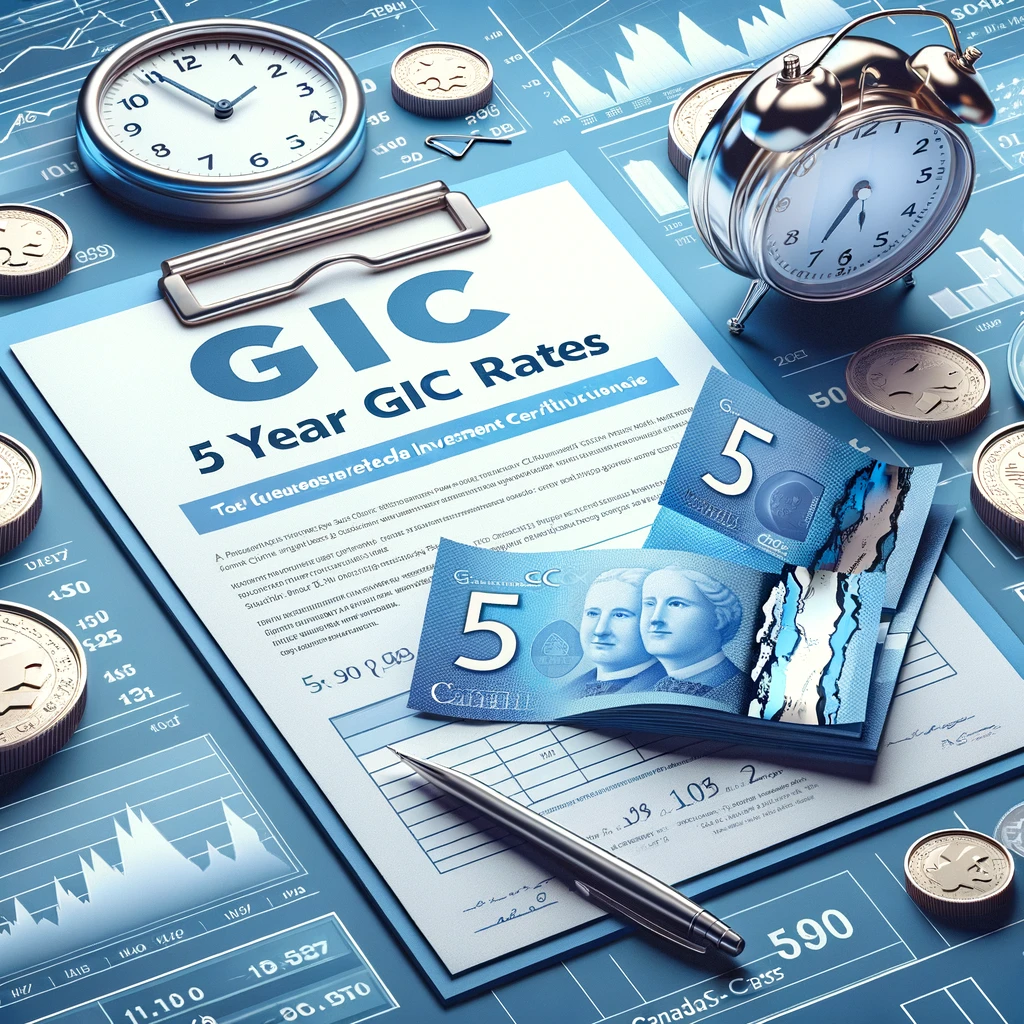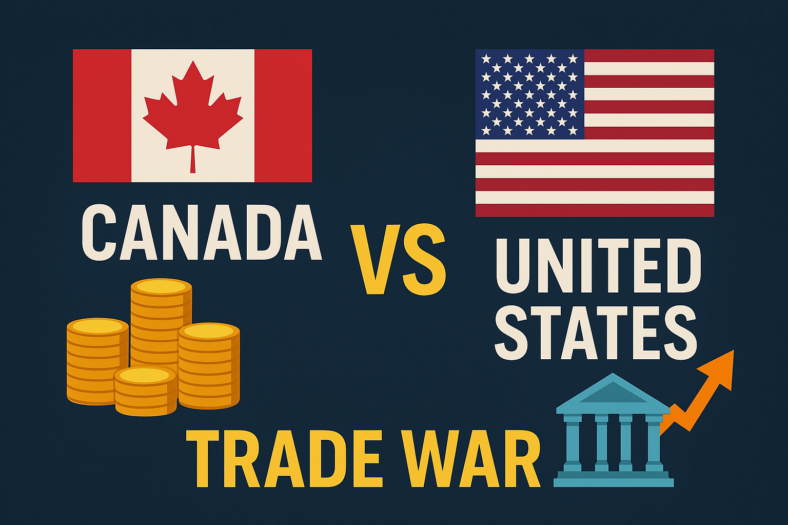When it comes to financial planning and investment strategies, finding reliable avenues to grow your money is paramount. Guaranteed Investment Certificates (GICs) have long been a staple in the portfolios of risk-averse investors seeking steady returns. In Canada, where financial stability and security are highly valued, GICs offer a safe haven for individuals looking to safeguard their capital while earning a respectable yield.
One of the key considerations when investing in GICs is the term length, with options ranging from as short as 30 days to as long as several years. Among these, the 5-year GIC stands out as an attractive choice for those seeking a balance between security and higher returns. With a longer term comes the potential for higher interest rates, providing investors with a predictable stream of income over an extended period.
However, not all 5-year GICs are created equal. Financial institutions across Canada offer varying rates, terms, and features, making it essential for investors to conduct thorough research to secure the best possible returns on their investment. In this comprehensive guide, we’ll delve into the top 5-year GIC rates available in Canada, exploring the key features, benefits, and considerations associated with each option. Whether you’re a seasoned investor or just beginning your journey towards financial prosperity, this guide will equip you with the knowledge needed to make informed decisions and maximize your investment potential. Let’s embark on this journey to uncover the best 5-year GIC rates that Canada has to offer.
Best GIC Rates – Our Top Picks
What are 5-year GICs?
5-year Guaranteed Investment Certificates (GICs) are fixed-term investments offered by financial institutions such as banks, credit unions, and trust companies. As the name suggests, these GICs have a maturity period of five years, meaning your investment is locked in for that duration.
Here’s how they typically work:
Term Length: As mentioned, 5-year GICs have a fixed term of five years. During this period, you cannot withdraw your funds without penalty, although some institutions may offer limited options for early withdrawal with reduced interest.
Interest Rate: The interest rate on a 5-year GIC is usually higher than shorter-term GICs to compensate for the longer commitment period. This higher rate provides investors with the potential for increased returns over the five-year term.
Guaranteed Returns: One of the primary attractions of GICs is their guaranteed returns. Unlike other investment options like stocks or mutual funds, where returns can fluctuate based on market conditions, the interest rate on a GIC is fixed for the entire term. This provides investors with a predictable stream of income and helps protect their principal investment.
Security: GICs are considered low-risk investments, especially when issued by reputable financial institutions. In Canada, deposits in GICs are typically insured up to a certain limit by the Canada Deposit Insurance Corporation (CDIC) or provincial deposit insurance programs, providing an additional layer of security for investors.
Investment Amount: The minimum investment amount for a 5-year GIC varies depending on the financial institution. Some institutions may require a minimum deposit, while others may offer flexibility in the amount you can invest.
Interest Payment Frequency: Interest on 5-year GICs can be paid out in different frequencies, such as monthly, quarterly, annually, or at maturity. The payment frequency can affect the overall yield of the investment, so it’s essential to consider your cash flow needs when selecting a payment schedule.
Overall, 5-year GICs offer investors a combination of stability, predictable returns, and potentially higher interest rates compared to shorter-term options. However, it’s crucial to assess your financial goals, risk tolerance, and liquidity needs before investing in any GIC to ensure it aligns with your investment strategy.
How do 5-year GICs work?
5-year Guaranteed Investment Certificates (GICs) operate as fixed-term investments, providing investors with a secure way to grow their money over a predetermined period. Here’s a detailed breakdown of how they work:
Investment Period: When you purchase a 5-year GIC, you are committing to leave your money invested for a fixed period of five years. During this time, your funds are locked in, and you generally cannot access them without incurring penalties. This fixed term provides financial institutions with the assurance that they can use your funds for lending and other activities over the specified period.
Interest Rate: The interest rate on a 5-year GIC is agreed upon at the time of purchase and remains constant throughout the term. This fixed interest rate distinguishes GICs from other investments, such as stocks or mutual funds, where returns can fluctuate based on market performance. The rate offered on a 5-year GIC is typically higher than shorter-term GICs to compensate for the longer commitment period.
Interest Calculation: Interest on a 5-year GIC can be calculated in various ways, including simple interest or compound interest. With simple interest, the interest is calculated only on the initial principal amount, while compound interest includes interest on both the principal and any accumulated interest. The method of interest calculation can significantly impact the overall returns on your investment.
Guaranteed Returns: One of the primary advantages of GICs is their guaranteed returns. Regardless of fluctuations in the financial markets, you are assured of receiving the agreed-upon interest rate on your investment. This guarantee provides investors with peace of mind and helps protect their principal investment.
Maturity: At the end of the five-year term, the GIC reaches maturity. Depending on the terms of the GIC, you have several options:
Renewal: Some financial institutions offer automatic renewal options, where your GIC is reinvested for another term if you don’t provide instructions to the contrary.
Redemption: You can choose to redeem (cash out) your GIC upon maturity. The principal amount, along with any accrued interest, will be returned to you.
Rollover: If you wish to continue investing in GICs, you can choose to roll over the matured amount into a new GIC, either with the same financial institution or a different one.
Risk and Security: GICs are considered low-risk investments, particularly when issued by reputable financial institutions. In Canada, deposits in GICs are typically insured up to a certain limit by the Canada Deposit Insurance Corporation (CDIC) or provincial deposit insurance programs, providing additional security for investors.
Overall, 5-year GICs offer investors a combination of stability, predictable returns, and security, making them a popular choice for those looking to preserve capital and earn a steady income over the long term.
Pros and cons of 5-year GICs
Pros:
Stability: 5-year GICs provide a stable investment option with guaranteed returns. The fixed interest rate offers predictability, allowing investors to plan for future income with confidence.
Security: GICs are considered low-risk investments, especially when issued by reputable financial institutions. In Canada, deposits in GICs are typically insured up to a certain limit by the Canada Deposit Insurance Corporation (CDIC) or provincial deposit insurance programs, providing additional security for investors.
Higher Interest Rates: Compared to shorter-term GICs, 5-year GICs often offer higher interest rates. This can result in greater returns over the long term, especially in periods of rising interest rates.
Long-Term Growth Potential: By locking in your investment for five years, you have the opportunity to benefit from compounded interest, which can enhance the overall growth of your investment over time.
Diversification: Including 5-year GICs in your investment portfolio can provide diversification, balancing higher-risk investments like stocks or mutual funds with a lower-risk asset class. This diversification can help mitigate overall portfolio risk.
Cons:
Lack of Liquidity: One of the main drawbacks of 5-year GICs is their lack of liquidity. Once you invest in a 5-year GIC, your funds are typically locked in for the entire term. Early withdrawal may incur penalties or forfeit a portion of the accrued interest, limiting access to your money when needed.
Opportunity Cost: Locking into a fixed-term investment like a 5-year GIC means missing out on potential opportunities that may arise during the term. If interest rates rise significantly or better investment options become available, you may not be able to take advantage of them until your GIC matures.
Inflation Risk: Inflation can erode the purchasing power of your returns over time. While GICs offer guaranteed returns, if the interest rate fails to outpace inflation, your real (inflation-adjusted) returns may be lower than expected.
Interest Rate Risk: If interest rates decline after you’ve invested in a 5-year GIC, you may miss out on higher returns available in the market. This risk is mitigated by the fixed interest rate offered by GICs, but it’s essential to consider potential changes in interest rate environments.
Limited Flexibility: Unlike other investments like stocks or bonds, where you can adjust your portfolio more frequently, GICs lock you into a fixed investment period. This lack of flexibility can be a drawback if your financial situation or investment goals change unexpectedly.
In summary, 5-year GICs offer stability, security, and potentially higher returns over the long term, but they come with limitations such as lack of liquidity and opportunity cost. It’s essential to weigh the pros and cons carefully and consider your financial goals and risk tolerance before investing in 5-year GICs.
Types of 5-year GICs available in Canada
In Canada, there are several types of 5-year Guaranteed Investment Certificates (GICs) available to investors, each offering different features and benefits. Here are some common types:
Fixed Rate GICs: These are the most straightforward type of GIC, where you invest a lump sum for a fixed term of five years at a specified interest rate. The interest rate remains constant throughout the term, providing predictability and stability.
Variable Rate GICs: Unlike fixed-rate GICs, variable rate GICs offer an interest rate that can fluctuate over the term based on changes in market conditions or a specific benchmark, such as the prime rate. While variable rate GICs offer the potential for higher returns if interest rates rise, they also come with increased uncertainty compared to fixed-rate GICs.
Cashable GICs: Cashable GICs provide investors with the flexibility to redeem their investment before the end of the term without incurring penalties. These GICs typically offer lower interest rates than non-redeemable GICs to compensate for the added liquidity.
Escalating Rate GICs: Escalating rate GICs feature an interest rate that increases incrementally over the term. For example, the rate may start lower in the initial years and gradually rise each year until maturity. These GICs appeal to investors who believe that interest rates will increase over time.
Market-Linked GICs: Market-linked GICs offer returns linked to the performance of underlying assets, such as stock market indices or a basket of securities. While these GICs provide the potential for higher returns, they also come with the risk of receiving lower or even no returns if the underlying assets perform poorly.
Foreign Currency GICs: Some financial institutions offer GICs denominated in foreign currencies, allowing investors to diversify their currency exposure. These GICs are subject to exchange rate fluctuations, which can impact returns.
Registered GICs: Registered GICs are held within registered accounts such as Registered Retirement Savings Plans (RRSPs), Tax-Free Savings Accounts (TFSAs), or Registered Education Savings Plans (RESPs). Investing in registered GICs offers tax advantages, such as tax-deferred or tax-free growth, depending on the type of account.
Non-Registered GICs: Non-registered GICs are held outside of registered accounts and are subject to taxation on interest income. While they don’t offer the same tax advantages as registered GICs, they provide flexibility in terms of contribution limits and withdrawals.
These are just a few examples of the types of 5-year GICs available in Canada. Each type caters to different investment objectives, risk tolerances, and liquidity needs, so it’s essential to carefully evaluate your options before investing.
How to find the best 5-year GIC rates in Canada
Finding the best 5-year Guaranteed Investment Certificate (GIC) rates in Canada requires thorough research and comparison of offerings from various financial institutions. Here’s a step-by-step guide to help you find the top rates:
Use Online Comparison Tools: Several websites and financial platforms offer tools to compare GIC rates from different institutions. These tools allow you to filter by term length, investment amount, and type of GIC to find the best rates that meet your criteria. Some popular comparison websites include Ratehub.ca, RateSupermarket.ca, and Cannex.com.
Check Bank Websites: Visit the websites of major banks, credit unions, and other financial institutions in Canada to view their current GIC rates. Banks often display their GIC rates prominently on their websites, making it easy to compare rates across multiple institutions.
Contact Financial Advisors: If you have a financial advisor or bank representative, reach out to them to inquire about current GIC rates and any special promotions or offers available. Financial advisors can provide personalized guidance based on your financial goals and risk tolerance.
Review Rate Tables: Many financial publications and websites publish rate tables that list the best GIC rates available in Canada. These tables are updated regularly and provide a convenient way to compare rates from different institutions in one place.
Consider Online Banks and Credit Unions: Online banks and credit unions often offer competitive GIC rates compared to traditional brick-and-mortar banks. Their lower overhead costs may allow them to pass on higher interest rates to customers. Explore offerings from online-only banks and credit unions to see if they have competitive rates for 5-year GICs.
Check for Promotions and Special Offers: Financial institutions occasionally run promotions or special offers on GICs to attract new customers or encourage existing customers to invest. Keep an eye out for promotional rates, bonus interest offers, or other incentives that could enhance the overall return on your investment.
Compare Terms and Conditions: In addition to comparing interest rates, be sure to review the terms and conditions of each GIC offering, including maturity dates, early redemption penalties, interest payment frequencies, and deposit insurance coverage. Consider factors such as liquidity, flexibility, and security when evaluating GIC options.
Read Customer Reviews and Ratings: Before finalizing your decision, take the time to read customer reviews and ratings of the financial institutions you’re considering. Look for feedback on customer service, account management, and overall satisfaction to ensure you’re choosing a reputable institution.
By following these steps and conducting thorough research, you can find the best 5-year GIC rates in Canada that align with your investment goals and preferences.
How to open a 5-year GIC
Opening a 5-year Guaranteed Investment Certificate (GIC) in Canada typically involves several steps, whether you’re applying online, over the phone, or in person at a financial institution. Here’s a general guide on how to open a 5-year GIC:
Research Financial Institutions: Start by researching different financial institutions that offer 5-year GICs and compare their rates, terms, and conditions. Consider factors such as interest rates, minimum investment amounts, deposit insurance coverage, and reputation.
Choose the Type of GIC: Determine the type of 5-year GIC that best suits your needs and preferences, such as fixed-rate, variable-rate, cashable, or registered GICs. Consider factors like liquidity, interest rate fluctuations, and tax implications when making your decision.
Gather Required Information: Before opening a 5-year GIC, you’ll need to gather certain personal and financial information, including:
- Full name
- Date of birth
- Social insurance number (SIN)
- Contact information (address, phone number, email)
- Identification documents (driver’s license, passport, or other government-issued ID)
- Banking information (if funding the GIC from an existing account)
Choose Funding Source: Decide how you’ll fund your 5-year GIC. You can typically fund a GIC through a transfer from your existing bank account, a cheque, or a direct deposit.
Contact the Financial Institution: Once you’ve chosen a financial institution and decided on the type of GIC you want to open, contact the institution through their website, phone, or visit a branch in person. You may also be able to open a GIC online through the institution’s website or mobile app.
Complete Application Form: Provide the necessary information and complete the application form to open the 5-year GIC. You may need to specify details such as the investment amount, term length, interest payment frequency, and beneficiary information.
Review and Sign Documents: Review all the terms and conditions of the GIC agreement, including any fees, penalties, or withdrawal restrictions. Once you’re satisfied with the terms, sign the necessary documents to finalize the GIC opening process.
Fund the GIC: If you haven’t already funded the GIC, provide the required funds through the chosen funding method (e.g., bank transfer, cheque).
Confirm Opening: After completing the application and funding the GIC, you’ll receive confirmation from the financial institution confirming the opening of your 5-year GIC. Keep a copy of the confirmation for your records.
Monitor Your Investment: Once your 5-year GIC is open, monitor its performance and keep track of important dates, such as maturity and interest payment dates. Review your GIC periodically to ensure it continues to meet your financial goals and needs.
By following these steps, you can open a 5-year GIC in Canada and start investing in a secure and predictable way to grow your savings over the long term.
Common fees for 5-year GICs
Common fees associated with 5-year Guaranteed Investment Certificates (GICs) in Canada vary depending on the financial institution and the specific terms of the GIC agreement. While GICs typically don’t have as many fees as other investment products like mutual funds or stocks, there are still a few charges to be aware of. Here are some common fees you might encounter:
Early Redemption Penalty: Many GICs have penalties for early withdrawal before the maturity date. The penalty is usually calculated as a percentage of the interest earned or a set number of days’ worth of interest. This fee discourages investors from accessing their funds before the agreed-upon term.
Administration Fees: Some financial institutions may charge administration fees for opening or maintaining a GIC account. These fees could be one-time charges or recurring annual fees. However, many institutions offer GICs with no administration fees, especially for larger investment amounts.
Transfer-Out Fees: If you want to transfer your GIC to another financial institution before maturity, you may encounter transfer-out fees. These fees cover the administrative costs associated with transferring the GIC to another institution.
Non-Redeemable GIC Fees: Non-redeemable GICs, which do not allow early withdrawal under any circumstances, may have additional fees or penalties for attempting to access funds before maturity.
Currency Exchange Fees: If you invest in a foreign currency GIC, you may incur currency exchange fees when converting your funds from Canadian dollars to the foreign currency and vice versa. These fees can vary depending on the financial institution and the exchange rate.
Inactive Account Fees: If your GIC account remains inactive for an extended period, some institutions may charge inactive account fees. To avoid these fees, ensure that you maintain regular activity in your GIC account, such as making deposits or withdrawals.
Overdraft Fees: If you fund your GIC with a cheque or electronic transfer that exceeds the available funds in your account, you may incur overdraft fees from your bank. Ensure that you have sufficient funds in your account to cover the GIC investment amount to avoid these fees.
It’s essential to carefully review the terms and conditions of any GIC agreement before investing to understand any potential fees or penalties. Additionally, compare GIC offerings from different financial institutions to find options with the most favorable fee structures for your investment needs. Many institutions offer GICs with no fees or competitive fee structures to attract investors.
What are the requirements to apply for a 5-year GIC
To apply for a 5-year Guaranteed Investment Certificate (GIC) in Canada, you’ll typically need to meet certain requirements set by the financial institution offering the GIC. While specific requirements may vary depending on the institution and the type of GIC you’re applying for, here are the general requirements you can expect:
Legal Age: You must be of legal age to enter into a financial contract in your province or territory of residence. In most provinces and territories in Canada, the legal age is 18, but it may vary in some regions.
Identification: You’ll need to provide valid identification documents to verify your identity. This may include government-issued photo identification such as a driver’s license, passport, or provincial identification card.
Social Insurance Number (SIN): Financial institutions typically require your Social Insurance Number (SIN) for tax reporting purposes, especially if you’re opening a registered GIC within a tax-advantaged account like an RRSP or TFSA.
Residency Status: You may need to confirm your residency status in Canada. While Canadian citizenship is not always required to open a GIC, you may need to provide proof of residency, such as a Canadian address or utility bill in your name.
Minimum Investment Amount: Most financial institutions have a minimum investment amount for GICs, including 5-year GICs. The minimum investment requirement varies depending on the institution and the type of GIC, but it’s typically a few hundred dollars or more.
Funding Source: You’ll need to specify the source of funds for your GIC investment. This could include transferring funds from an existing bank account, writing a cheque, or arranging a direct deposit.
Application Form: Complete the application form provided by the financial institution. The application form will require you to provide personal information, such as your full name, address, contact details, and banking information.
Signature: You’ll need to sign the necessary documents to open the GIC account and agree to the terms and conditions of the GIC agreement.
Tax Information (for Registered GICs): If you’re opening a registered GIC within a tax-advantaged account like an RRSP, TFSA, or RESP, you may need to provide additional tax-related information, such as your contribution room or beneficiary details.
Compliance with Anti-Money Laundering (AML) Regulations: Financial institutions are required to comply with anti-money laundering regulations and may ask for additional information or documentation to verify the source of funds and ensure compliance with regulatory requirements.
It’s essential to review the specific requirements and procedures outlined by the financial institution where you plan to open the 5-year GIC to ensure a smooth application process. If you have any questions or concerns about the requirements, don’t hesitate to contact the institution’s customer service for clarification.
Alternatives to 5-year GICs
There are several alternative investment options to 5-year Guaranteed Investment Certificates (GICs) available in Canada, each with its own features, benefits, and considerations. Here are some common alternatives to consider:
High-Interest Savings Accounts (HISAs): High-interest savings accounts offer competitive interest rates compared to traditional savings accounts, making them an attractive option for short- to medium-term savings goals. HISAs provide easy access to funds, flexibility in deposits and withdrawals, and often require no minimum balance.
Government Bonds: Government bonds, such as Canada Savings Bonds or provincial savings bonds, are debt securities issued by the government. They typically offer fixed interest rates and various maturity periods, allowing investors to tailor their investment to their specific needs. Government bonds are considered relatively safe investments, backed by the government’s credit.
Corporate Bonds: Corporate bonds are debt securities issued by corporations to raise capital. They offer fixed interest payments over a specified period, with the principal amount repaid at maturity. Corporate bonds may offer higher yields than government bonds but also carry higher credit risk, as they are subject to the creditworthiness of the issuing corporation.
Dividend-Paying Stocks: Dividend-paying stocks are shares of companies that distribute a portion of their profits to shareholders in the form of dividends. Investing in dividend stocks can provide a source of regular income and potential capital appreciation over the long term. However, stocks are subject to market volatility and may not be suitable for investors with low risk tolerance.
Bond Funds: Bond funds, also known as fixed-income funds, invest in a diversified portfolio of bonds issued by governments, municipalities, and corporations. Bond funds offer professional management, diversification, and liquidity, making them a convenient option for investors seeking exposure to the bond market without directly owning individual bonds.
Balanced Funds: Balanced funds, also known as asset allocation funds, invest in a mix of stocks, bonds, and other asset classes to achieve a balanced portfolio. These funds offer diversification across different asset types, helping to mitigate risk while potentially providing steady returns over the long term.
Real Estate Investment Trusts (REITs): REITs are investment vehicles that own and manage income-generating real estate properties. Investing in REITs allows investors to gain exposure to the real estate market without directly owning physical properties. REITs typically distribute a significant portion of their income to shareholders in the form of dividends.
Exchange-Traded Funds (ETFs): ETFs are investment funds that trade on stock exchanges and hold assets such as stocks, bonds, commodities, or a combination thereof. ETFs offer diversification, liquidity, and low-cost access to various asset classes, making them a popular choice for investors seeking broad market exposure.
When evaluating alternative investment options to 5-year GICs, consider factors such as risk tolerance, investment goals, time horizon, and liquidity needs. It’s essential to conduct thorough research and consult with a financial advisor to determine the most suitable investment strategy for your individual circumstances.
FAQs about the best 5-year GICs in Canada
A 5-year GIC is a fixed-term investment offered by financial institutions in Canada. It involves investing a sum of money for a period of five years at a predetermined interest rate, with the principal and interest guaranteed at maturity.
To find the best 5-year GIC rates, you can use online comparison tools, check bank websites, contact financial advisors, review rate tables, consider online banks and credit unions, check for promotions, and compare terms and conditions.
Investing in a 5-year GIC offers stability, security, guaranteed returns, potential for higher interest rates, and long-term growth potential. It can also provide diversification in an investment portfolio and protection against market volatility.
Risks associated with 5-year GICs include lack of liquidity, opportunity cost of missing out on better investment opportunities, inflation risk, interest rate risk, and limited flexibility in accessing funds before maturity.
To open a 5-year GIC, you typically need to research financial institutions, choose the type of GIC, gather required information, contact the financial institution, complete an application form, review and sign documents, fund the GIC, and confirm the opening of the account.
Requirements to apply for a 5-year GIC include being of legal age, providing identification, a Social Insurance Number (SIN), residency status, meeting minimum investment amounts, specifying a funding source, completing an application form, and complying with anti-money laundering regulations.
Common fees associated with 5-year GICs include early redemption penalties, administration fees, transfer-out fees, non-redeemable GIC fees, currency exchange fees (for foreign currency GICs), inactive account fees, and overdraft fees.
Alternatives to 5-year GICs include high-interest savings accounts, government bonds, corporate bonds, dividend-paying stocks, bond funds, balanced funds, real estate investment trusts (REITs), and exchange-traded funds (ETFs).
In conclusion, investing in the best 5-year Guaranteed Investment Certificate (GIC) rates in Canada offers a reliable and secure way to grow your savings over the long term. With their stable returns, guaranteed principal, and potential for higher interest rates, 5-year GICs are a popular choice among investors seeking to preserve capital and earn steady income.
By conducting thorough research, comparing rates, and considering factors such as liquidity, fees, and terms and conditions, investors can find the best 5-year GIC that aligns with their financial goals and risk tolerance. Whether you’re a seasoned investor or just starting your investment journey, the comprehensive guide provided here equips you with the knowledge needed to navigate the landscape of 5-year GICs in Canada.
It’s essential to review your investment strategy periodically and reassess your financial goals to ensure that your 5-year GICs continue to meet your needs over time. By staying informed and making informed decisions, you can maximize the potential returns on your investments while safeguarding your financial future.
In the ever-changing landscape of personal finance, the quest for the best 5-year GIC rates in Canada remains a cornerstone of prudent wealth management. With diligence, patience, and a clear understanding of your investment objectives, you can confidently navigate the realm of 5-year GICs and embark on a path toward long-term financial prosperity.




















